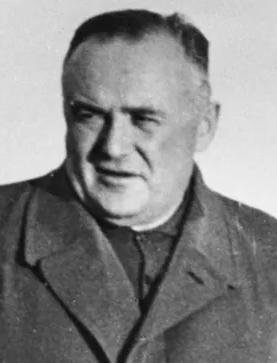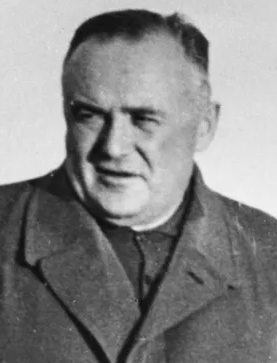


Sergei Pavlovich Korolev (1907–1966) was a Soviet aerospace engineer and rocket scientist who is often regarded as the chief architect of the Soviet space program. Korolev was instrumental in developing the technology that launched the first human-made satellite, Sputnik 1, and put the first human, Yuri Gagarin, into space. As the Chief Designer, Korolev led the Soviet Union's efforts during the Space Race against the United States, pioneering human space exploration. His work laid the foundation for many of the space exploration technologies that are still in use today.
Birth and Early Childhood: Sergei Korolev was born on January 12, 1907, in Zhytomyr, in present-day Ukraine, which was then part of the Russian Empire. His parents, Maria Moskalenko and Pavel Korolev, separated when he was a young child, and he spent much of his early life with his maternal grandparents in Nizhyn, Ukraine. His mother eventually remarried, and Korolev moved with her and his stepfather to Odessa, where he showed an early interest in engineering and aviation.
Education and Early Interest in Aviation: Korolev attended the Odessa Building Trades School, where he excelled in mathematics and engineering. He joined a local glider club, and his fascination with aviation led him to pursue formal education in the field. In 1926, Korolev enrolled at the Kyiv Polytechnic Institute, but he soon transferred to the Moscow Higher Technical School (MVTU), where he studied under renowned aviation pioneers such as Andrei Tupolev. Korolev graduated in 1930 as an aeronautical engineer and began working on the design of gliders and aircraft.
GIRD and Rocketry Experiments: In the early 1930s, Korolev became involved in the development of rocket technology in the Soviet Union. He joined the Group for the Study of Reactive Motion (GIRD), an early rocket research group, where he worked alongside other pioneers such as Friedrich Zander. GIRD conducted some of the Soviet Union's first successful liquid-fueled rocket tests, which attracted the attention of the Soviet government. Korolev quickly rose to prominence as a leading figure in the emerging field of rocketry.
Arrest and Imprisonment (1938): During Joseph Stalin's Great Purge in 1938, Korolev was arrested by the NKVD on charges of "sabotage" and "anti-Soviet activities." He was sentenced to ten years in a Gulag labor camp in Kolyma, in Siberia, where he endured brutal conditions. In 1940, thanks to intervention from influential figures, including Andrei Tupolev, Korolev's sentence was commuted, and he was transferred to a sharashka, a special prison for scientists and engineers, where he continued to work on aviation and rocketry projects.
World War II and the V-2 Rockets: During World War II, Korolev's expertise became crucial to Soviet efforts to develop rocket technology. He worked on designing jet-assisted takeoff (JATO) units for aircraft and studied the technology of the German V-2 rockets after the war. When the Soviet forces captured Peenemünde, the site of Nazi Germany's rocket development, Korolev played a key role in reverse-engineering the V-2 and using the knowledge to advance Soviet rocketry.
Appointment as Chief Designer: In 1946, Korolev was appointed the Chief Designer of the Soviet Union’s ballistic missile program. Although his identity remained a closely guarded secret throughout his life—he was publicly referred to only as the "Chief Designer"—Korolev was the mastermind behind nearly all of the Soviet Union's significant achievements in space exploration during the 1950s and 1960s.
R-7 Semyorka and the Space Program: Korolev's work led to the development of the R-7 Semyorka, the world's first intercontinental ballistic missile (ICBM), which also served as the launch vehicle for many of the Soviet Union's space missions. The success of the R-7 laid the groundwork for the Sputnik program, which would soon catapult the Soviet Union into the global spotlight.
Sputnik 1 (1957): On October 4, 1957, Korolev and his team successfully launched Sputnik 1, the first artificial satellite to orbit the Earth. The launch of Sputnik was a groundbreaking achievement that marked the beginning of the Space Age. The success of Sputnik 1 not only demonstrated the Soviet Union's technological capabilities but also sparked the Space Race between the United States and the Soviet Union, becoming a symbol of Soviet scientific and technological prowess.
Sputnik 2 and Laika (1957): Following the success of Sputnik 1, Korolev oversaw the launch of Sputnik 2 on November 3, 1957, which carried Laika, a stray dog from Moscow, into space. Laika became the first living creature to orbit the Earth, though she did not survive the journey. The mission was important in demonstrating that living beings could endure the conditions of space travel.
Luna Program and Exploration of the Moon (1959–1960s): Under Korolev’s leadership, the Soviet Union launched a series of successful Luna missions to explore the Moon. Luna 2, launched in 1959, was the first human-made object to reach the Moon, and Luna 3 took the first images of the far side of the Moon. These missions provided valuable information about the lunar surface and were significant milestones in space exploration.
Vostok Program and Yuri Gagarin (1961): Korolev's crowning achievement came with the Vostok program, which aimed to put the first human in space. On April 12, 1961, Yuri Gagarin became the first person to travel into space and orbit the Earth aboard Vostok 1, a feat that stunned the world and cemented Korolev's reputation as a pioneer of space exploration. Gagarin’s successful mission was a monumental achievement for the Soviet Union and a major victory in the Space Race.
Vostok and Voskhod Programs: Following Gagarin's flight, Korolev continued to lead the Soviet crewed space program. He oversaw subsequent Vostok missions, which included longer flights and multiple cosmonauts. In 1964, the Voskhod 1 mission became the first spaceflight to carry more than one crew member, and in 1965, Voskhod 2 achieved the first spacewalk by cosmonaut Alexei Leonov.
Ambitions for the Moon and Mars: After the success of the early space missions, Korolev focused on more ambitious projects, including a plan to land a Soviet cosmonaut on the Moon before the United States. He worked on developing the N1 rocket, a massive launch vehicle intended for lunar missions. Korolev also dreamed of eventual missions to Mars and beyond. However, the development of the N1 rocket was fraught with challenges and setbacks, partly due to the enormous technical difficulties involved and the pressure of competing with the United States.
Secrecy and Challenges: Throughout his career, Korolev's identity as the Chief Designer remained classified. The extreme secrecy of the Soviet space program and the intense political pressure placed a significant strain on Korolev. Despite the many successes, he faced numerous obstacles, including a lack of resources, technical difficulties, and political interference.
Death (1966): Sergei Korolev died unexpectedly on January 14, 1966, at the age of 59, following complications from surgery to remove a tumor. His death was a significant blow to the Soviet space program. The secrecy surrounding his life meant that many of his contributions remained unacknowledged during his lifetime, but after his death, the Soviet Union revealed his identity and honored his achievements. He was buried in the Kremlin Wall Necropolis in Moscow, a sign of his importance to the Soviet state.
Impact on the Soviet Space Program: Korolev's death had a lasting impact on the Soviet space program. Without his leadership and vision, the Soviet Union struggled to maintain its early lead in the Space Race. The N1 rocket, which Korolev had been developing for a potential lunar mission, ultimately failed in multiple test flights, and the Soviet Union was unable to achieve a crewed Moon landing before the United States, which succeeded with Apollo 11 in 1969.
Legacy and Honors: Sergei Korolev is remembered as the father of the Soviet space program and one of the greatest space pioneers in history. His leadership and vision were instrumental in achieving many of the Soviet Union's early successes in space exploration. After his death, numerous honors were bestowed upon him, including the naming of the city of Korolev, near Moscow, in his memory. His former design bureau, OKB-1, was also renamed to honor his legacy and became known as the Energia Corporation, continuing to play a key role in the Russian space industry.
Rocketry and Spacecraft Design: Korolev's contributions to rocket engineering and spacecraft design were instrumental in the development of space technology. He was a brilliant engineer who combined technical knowledge with a visionary approach, driving innovation in a field that was still in its infancy. His designs for the R-7 rocket and Vostok spacecraft were groundbreaking and helped establish the Soviet Union as a leader in space exploration.
Vision for Space Exploration: Korolev’s vision extended beyond the immediate goals of putting satellites and cosmonauts into orbit. He believed in the potential for human space exploration and dreamed of missions to the Moon, Mars, and beyond. His work paved the way for future advancements in space exploration and inspired generations of engineers and scientists to pursue space exploration as a field of study.
Human Spaceflight and the Space Race: Korolev's success in launching the first satellite and sending the first human into space marked significant milestones in the Space Race and reshaped global perceptions of the Soviet Union's technological capabilities. The Soviet Union's early victories in space exploration were largely due to Korolev’s leadership, and his contributions had a lasting impact on the development of human spaceflight.
Sergei Korolev was a visionary engineer and the driving force behind the Soviet Union's remarkable achievements in space exploration during the 1950s and 1960s. His leadership of the Soviet space program led to some of the most significant milestones in space history, including the launch of Sputnik 1 and Yuri Gagarin's historic flight into space. Despite facing personal hardships, including imprisonment and secrecy, Korolev remained dedicated to advancing rocketry and making human space exploration a reality.
Korolev's legacy as the father of the Soviet space program endures to this day, and his contributions laid the foundation for many of the advancements that followed in space science and technology. He remains a symbol of the ingenuity and determination that defined the early years of space exploration, and his work continues to inspire space scientists, engineers, and enthusiasts around the world.

We use cookies
We use cookies and other tracking technologies to improve your browsing experience on our website, to show you personalized content and targeted ads, to analyze our website traffic, and to understand where our visitors are coming from. Privacy Policy.